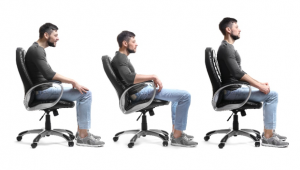How to Improve Posture While Working From Home
This blog about posture is how to really improve posture AND reduce the likelihood of falling into bad postural positions while working from home.
Because we’ve dedicated the last two weeks of this toolkit to avoiding slipping into poor posture and the dangers of doing so, I’m going to dedicate this week’s blog more towards practical advice.
Studies show that employees spend around 62% of their workday sitting (1), which gives a lot of time for slouching and can also lead to chronic diseases and mortality (2).
Why is posture important?
We have several sources on the website that explain the importance of improving posture, such as our blog ‘’The Posture Conundrum Pt 1’’. As an overview, retaining good posture is important to avoid pain and discomfort (3), but most workplaces will contribute to poor posture unless the desk and chair have been set up correctly. Now that you’ve transitioned to your home, the chance of you having a set-up that will avoid harming your posture is lower.
Posture suggestions
Sitting to standing:
Standing or active workstations have been in vogue recently, with most of the research pointing to their effectiveness in improving people’s posture, general health and physical activity levels while at work (4).
Not only does a sit/stand option for working help with improving health, but they don’t impact on work performance in the following areas:
- Computer and mouse performance
- Grammar and spelling accuracy
- Speaking quality
- Cognitive functioning (5)
Orange and laser beam:
This is seemingly one of the more random titles of a posture blog! This is a postural cue that is designed to imagine two things, an orange and a laser beam, to help you hold a better posture.
Because your body wants to focus your eyes straight on the horizon, it is impossible for anyone to hold good posture when their chin is not parallel with the group. Most patients I see lift their chin up when they go into ‘’good posture’’, so I developed a technique to stop this from happening.
This is simple, but difficult to accomplish. Initially, I want you to imagine that you have an orange placed underneath your chin. Hold that orange there, almost as if you want to start giving yourself a double chin. Now, to avoid your head nodding downwards too much, I also want you to imagine that you have a laser beam in the middle of your forehead. This laser beam needs to be shooting straight forwards, so don’t let it shoot downwards from your forehead.
Give this technique a try, and hopefully, it’ll work for you to improve your posture as it has for many others!
Tape over shoulder blades:
I know what you’re thinking – ‘’are you asking me to apply Sellotape to my upper back so that I sit up straight?’’ The answer is, “yes”, if that is a postural cue that works effectively for you. Tape in between the shoulder blades is something I have used with patients for a while now. It may sound uncomfortable, messy and awkward but I guarantee you’ll only feel the pull of the tape if you enter into bad posture.
This is done with a few steps:
- Find any medical plaster or tape (Sellotape, duct tape etc) that won’t be an irritant to your skin.
- Squeeze your shoulder blades backwards by around 2-3cm, while bringing your head into a retracted (see paragraph above on ‘’orange and laser beam’’) position you feel you can manage.
- Ask a partner to gently apply the tape over your shoulder blades.
- You should ideally not feel the tape unless you enter into bad posture. At this point, you will get a reminder and you will sit up straight.
Exercises to improve posture
Head retraction: Head retraction exercises use the orange and laser beam method and bring the head backwards, instead of the stooped posture forwards:
Shoulder retraction: Very similar to head retraction. This exercise can be done with weights if you are lying face down on a bench:
Rear deltoid (requires band): Another great exercise to strengthen your rear shoulder muscles, keeping your posture erect.
For any further questions, please don’t hesitate to ask:
0161 209 2980
info@movementandwellbeingclinic.co.uk
Ed Madeley M.Ost
References
- Aittasalo M, Livson M, Lusa S, Romo A, Vähä-Ypyä H, Tokola K, Sievänen H, Mänttäri A, Vasankari TBMC Public Health. 2017 Apr 17; 17(1):319.
- van Uffelen JG, Wong J, Chau JY, van der Ploeg HP, Riphagen I, Gilson ND, Burton NW, Healy GN, Thorp AA, Clark BK,. Gardiner PA, Dunstan DW, Bauman A, Owen N, Brown WJ Am J Prev Med. 2010 Oct; 39(4):379-88.
- Mckenzie R: Treat your own neck. Spinal Publications, 1997.
- Torbeyns T, Bailey S, Bos I, Meeusen R. Sports Med. 2014 Sep; 44(9):1261-73.
- Beers EA, Roemmich JN, Epstein LH, Horvath PJ Eur J Appl Physiol. 2008 Increasing passive energy expenditure during clerical work.; 103(3):353-60.
